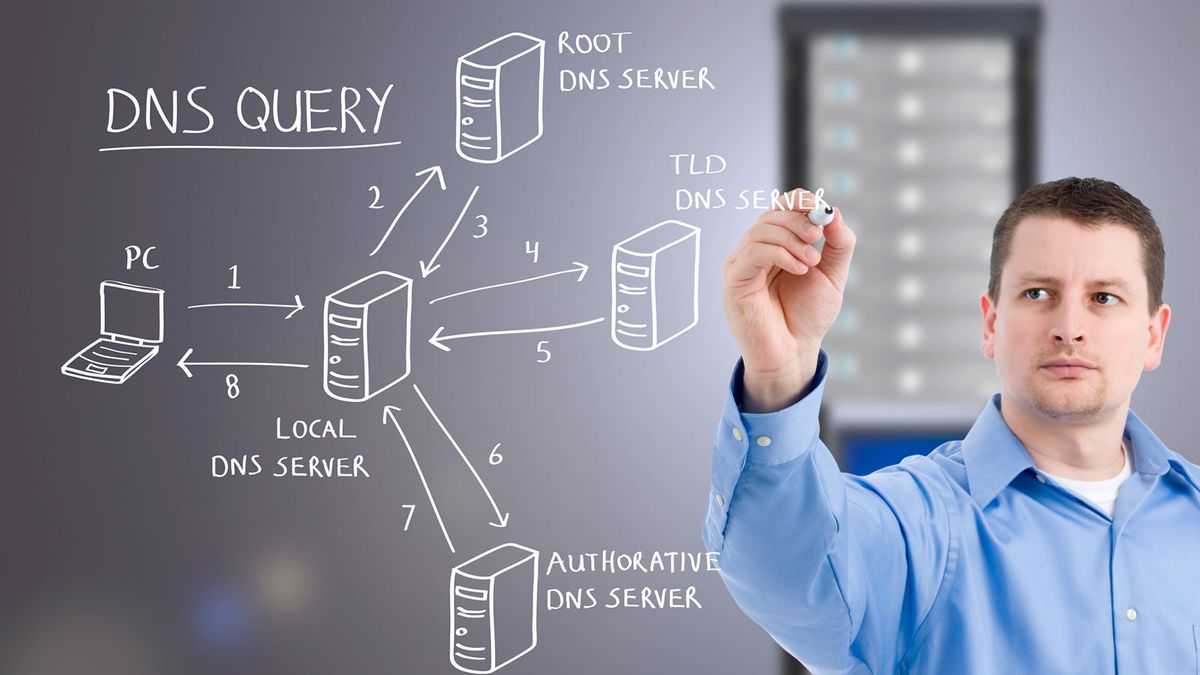
What is DNS Management?
DNS management is a critical aspect of internet infrastructure, often likened to the phonebook of the internet. The Domain Name System (DNS) is what allows users to access websites using domain names instead of IP addresses, which are much harder to remember. Management of DNS involves overseeing the DNS records and configuration settings for a domain, ensuring that the domain's website and services are accessible to users around the globe. In this article, we'll delve into what DNS management encompasses, the types of DNS records, and why effective DNS management is crucial for businesses and individuals alike.

Understanding DNS
Before we dive into DNS management, it's important to understand what DNS is. The Domain Name System is a hierarchical and decentralized naming system for computers, services, or any resource connected to the internet or a private network. It translates more readily memorized domain names (like www.example.com) to the numerical IP addresses needed for locating and identifying computer services and devices with the underlying network protocols.
What is DNS Management?
DNS management refers to the process of overseeing the DNS records and settings for a domain. This includes a wide range of tasks, from configuring basic DNS records to securing a domain's DNS to prevent malicious activities like DNS hijacking. DNS management can be performed through a DNS hosting provider, which often comes along with domain registration, or through a dedicated DNS management service for more complex needs.
Types of DNS Records
Understanding DNS management requires familiarity with the various types of DNS records. Here are a few of the most common:
- A Record (Address Record): Links a domain to the IP address of the server hosting the domain's content.
- CNAME Record (Canonical Name Record): Redirects one domain to another domain, allowing multiple domains to point to the same IP address without specifying an IP address directly.
- MX Record (Mail Exchange Record): Directs email to a domain's mail servers, specifying where emails sent to the domain should be routed.
- TXT Record (Text Record): Allows administrators to insert arbitrary text into a DNS record, often used for email verification and security protocols like SPF and DKIM.
- NS Record (Name Server Record): Specifies the servers that are authoritative for a domain, directing where DNS queries should be sent to find out the IP addresses of the domain's servers.

Why is DNS Management Important?
DNS management plays a pivotal role in the functionality and security of a domain. Here are some key reasons why effective DNS management is essential:
- Accessibility: Proper DNS settings ensure that your website and services are accessible to users worldwide. Misconfigured DNS can lead to downtime and inaccessibility.
- Performance: Efficient DNS management can improve website loading times. By optimizing DNS settings, such as reducing the time to live (TTL) values for DNS records, changes can propagate faster, improving the overall user experience.
- Security: DNS is a prime target for cyberattacks. Effective DNS management includes implementing security measures like DNSSEC (DNS Security Extensions) to protect against DNS spoofing and ensuring that your DNS provider has robust security practices.
- Flexibility and Control: Advanced DNS management allows for more precise control over how traffic is routed to your services, enabling load balancing and geo-routing to direct users to the nearest or most optimal server.
As we delve deeper into the nuances of DNS management, it becomes clear that this area is not just about maintaining status quo functionality but also about leveraging DNS to enhance and secure digital infrastructure. Here are some advanced aspects and considerations in DNS management that underscore its importance and complexity.

Advanced DNS Management Features
- GeoDNS: GeoDNS, or Geographical DNS, allows for the distribution of web traffic based on the geographical location of the visitor. This can significantly reduce latency, improve load times, and enhance the user experience by directing users to the server closest to them.
- Failover Services: DNS failover services can monitor your website's health and automatically redirect traffic to a backup site or server in case of a failure, ensuring continuous availability.
- DNS Load Balancing: Similar to traditional load balancers, DNS-based load balancing distributes traffic across multiple servers or data centers. This not only helps in managing traffic spikes efficiently but also in maintaining high availability and redundancy.
- DNSSEC: DNS Security Extensions (DNSSEC) adds an additional layer of security to DNS lookups by enabling DNS responses to be validated. This prevents attackers from manipulating or poisoning DNS data, thereby thwarting DNS spoofing attacks.
Challenges in DNS Management
While DNS management is vital, it is not without its challenges. Here are a few common issues:
- Complexity: As the DNS infrastructure becomes more sophisticated, managing it can become increasingly complex, requiring a deep understanding of DNS principles and best practices.
- Security Threats: The DNS system is a prime target for various cyber attacks, including DNS spoofing, DDoS attacks on DNS servers, and DNS hijacking. Staying ahead of potential security threats requires constant vigilance and up-to-date security measures.
- Propagation Delays: Changes to DNS records don’t happen instantaneously. They can take anywhere from a few minutes to 48 hours to propagate worldwide, which can be challenging when trying to resolve issues or update configurations promptly.
Best Practices for DNS Management
To navigate the complexities and challenges of DNS management effectively, here are some best practices:
- Regular Audits: Regularly review and audit your DNS settings and records to ensure they are correctly configured and optimized for
performance and security. This includes checking for stale or unnecessary records that could confuse or delay DNS resolution.
-
Use DNS Monitoring Tools: Utilize DNS monitoring tools to track the health and performance of your DNS infrastructure. These tools can alert you to issues such as high latency, failed DNS lookups, or unauthorized changes to DNS records.
-
Implement DNS Security Features: Activate security features such as DNSSEC to protect against DNS spoofing and ensure the integrity of DNS data. Also, consider using additional security measures like rate limiting and IP whitelisting to defend against DDoS attacks.
-
Choose a Reliable DNS Provider: The choice of DNS provider is critical. Opt for a provider known for its reliability, speed, and security features. A provider with a global network of DNS servers can offer lower latency and higher redundancy.
-
Plan for Redundancy: Ensure that your DNS setup includes redundancy to withstand failures. This can mean using multiple DNS providers or setting up secondary DNS servers that can take over in case the primary server fails.
-
Educate and Train Staff: Given the complexities and evolving nature of DNS, it's essential to ensure that your team is well-educated about DNS management best practices and the latest in DNS security threats and mitigation strategies.
-
Stay Informed: The DNS landscape is continuously evolving, with new technologies and threats emerging regularly. Stay informed about the latest trends and updates in the DNS world to ensure your DNS management strategies remain effective and secure.
Frequently Asked Questions about DNS Management
DNS management refers to the process of overseeing and configuring the DNS records and settings for a domain name. This includes tasks like setting up A Records, MX Records, managing DNS zones, and ensuring that the domain’s website and email services are accessible to users.
Effective DNS management is crucial for ensuring that your website is accessible, email services run smoothly, and to protect against security threats. It also plays a significant role in optimizing your site’s performance and reliability.
The most common DNS records include:
- A Record: Links a domain to an IP address.
- CNAME Record: Redirects one domain name to another.
- MX Record: Directs mail to an email server.
- TXT Record: Provides text notes to external sources.
- NS Record: Specifies authoritative DNS servers for a domain.
Yes, through techniques like GeoDNS for geographically distributed traffic, DNS load balancing, and optimizing TTL (Time to Live) values, DNS management can significantly improve website performance and reduce latency.
DNSSEC (DNS Security Extensions) adds a layer of security by enabling DNS responses to be validated. This helps prevent attackers from manipulating or poisoning DNS data, protecting against DNS spoofing attacks.
Challenges include managing complex configurations, protecting against security threats like DNS hijacking or DDoS attacks, and handling propagation delays when DNS changes are made.
Best practices include conducting regular DNS audits, utilizing DNS monitoring tools, implementing security measures like DNSSEC, and staying informed about the latest DNS threats and solutions.
DNS changes can take anywhere from a few minutes to 48 hours to fully propagate worldwide, depending on the TTL settings of the DNS records.
Yes, you can manage DNS settings yourself through your domain registrar or a dedicated DNS hosting service. However, it requires a basic understanding of DNS principles and careful attention to detail.
Misconfigured DNS can lead to your website becoming inaccessible, email delivery failures, and vulnerability to cyber attacks. It's essential to ensure accurate DNS configuration and regular monitoring.
Conclusion
DNS management is a cornerstone of internet functionality, directly impacting the accessibility, performance, and security of online services. It requires a proactive and knowledgeable approach, combining best practices in configuration and security with a readiness to adopt new technologies and strategies as they emerge. By understanding the intricacies of DNS management and implementing robust management practices, businesses and IT professionals can ensure that their online presence is both resilient and optimized for the digital age. As we become increasingly reliant on digital services, the role of effective DNS management will only grow in importance, making it an essential area of focus for anyone responsible for maintaining an online presence.
Here are some useful references for further reading on DNS management:
-
ICANN - Domain Name System Basics
ICANN DNS Basics
This resource provides an overview of the DNS, how it works, and its significance. -
Cloudflare - What is DNS?
Cloudflare DNS Guide
A comprehensive guide that explains DNS in detail, along with various types of DNS records. -
DigitalOcean - How To Set Up and Manage DNS Records
DigitalOcean DNS Management
This tutorial covers the basics of DNS records, how to create them, and best practices for managing them. -
Google Cloud - Introduction to DNS
Google Cloud DNS Documentation
Google’s documentation provides insights into how DNS works in cloud environments, including management practices. -
DNSimple - What is DNS Management?
DNSimple DNS Management
An overview of DNS management concepts, including record types and management tips. -
DNSSEC - Domain Name System Security Extensions
DNSSEC Overview
Information on DNSSEC, its purpose, and how it adds security to DNS. -
Namecheap - Complete Guide to DNS Records
Namecheap DNS Records Guide
An easy-to-understand breakdown of various DNS record types and their functions.
These resources can provide you with a deeper understanding of DNS management, best practices, and technical details.






